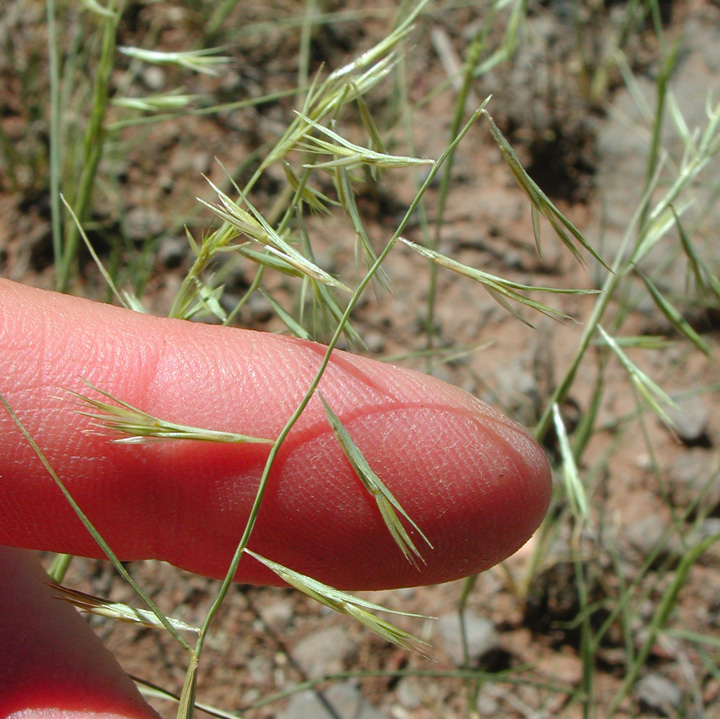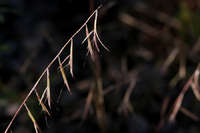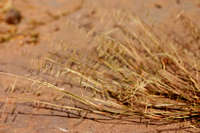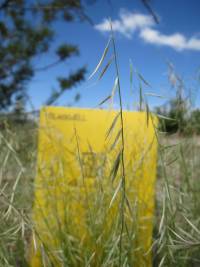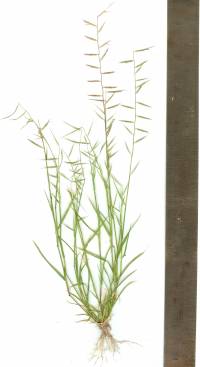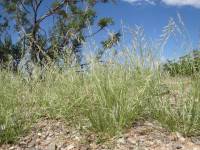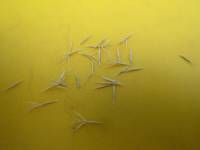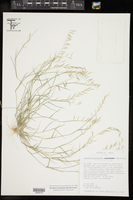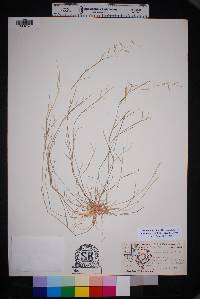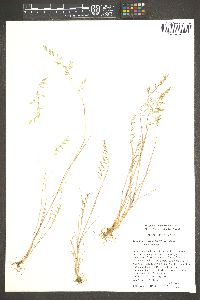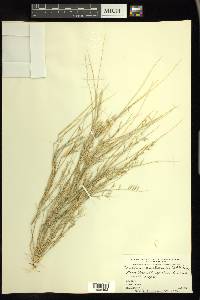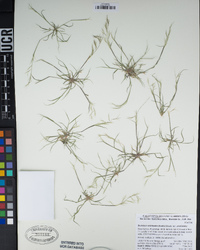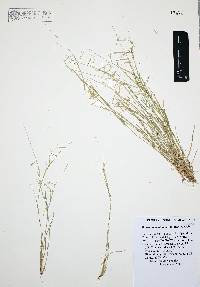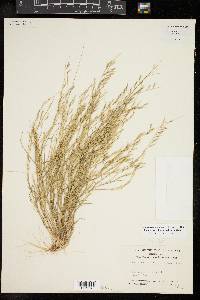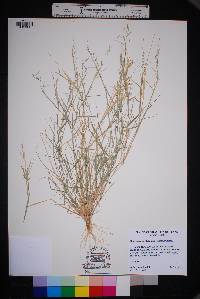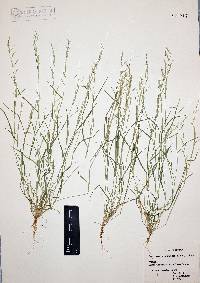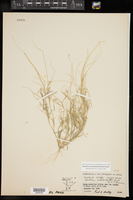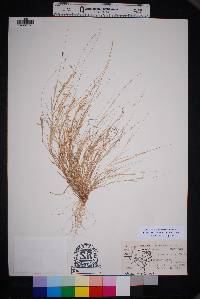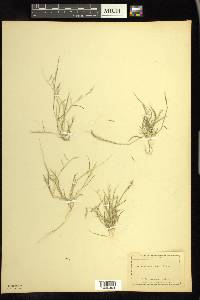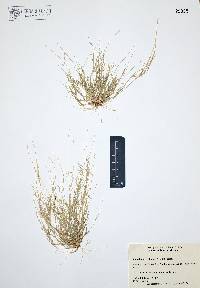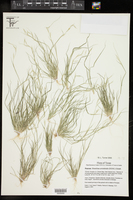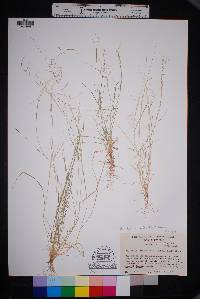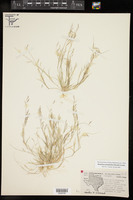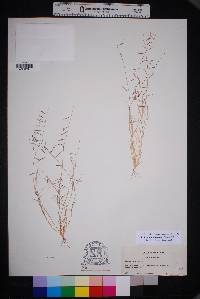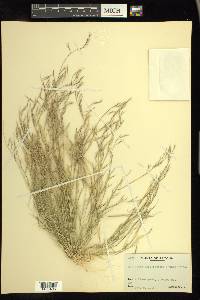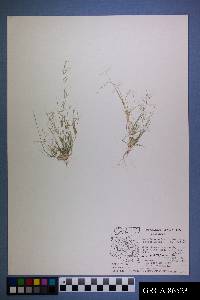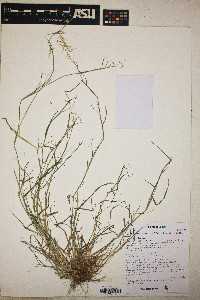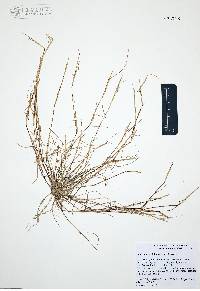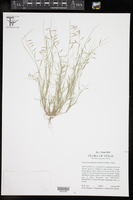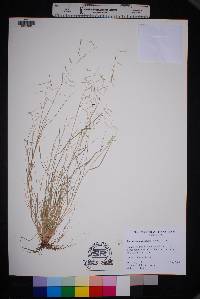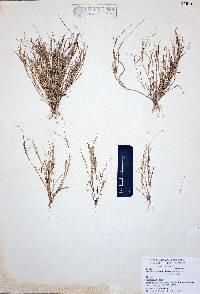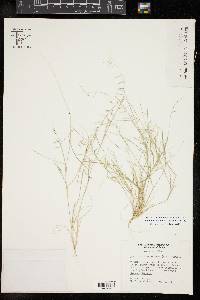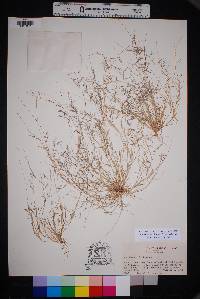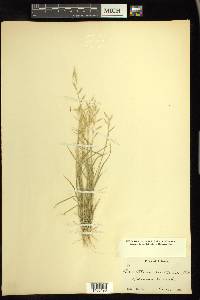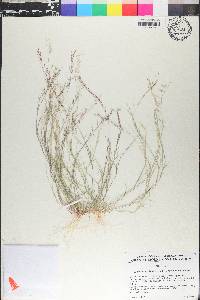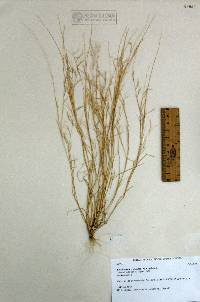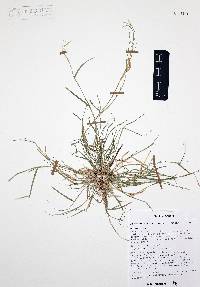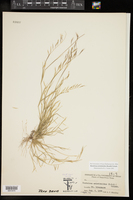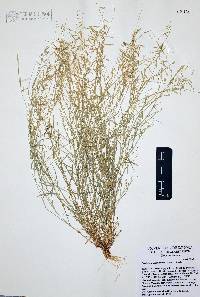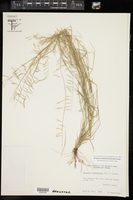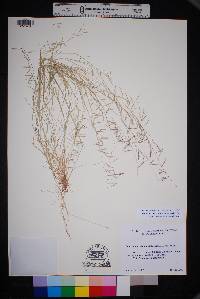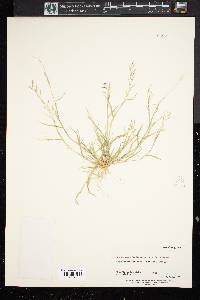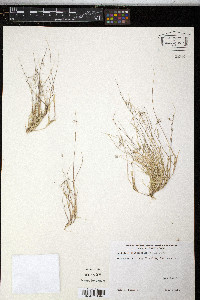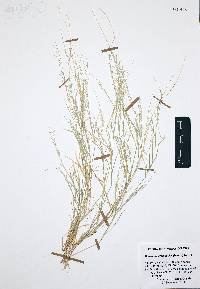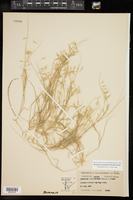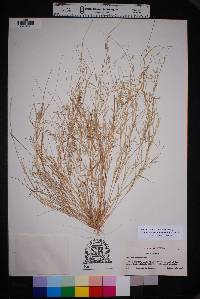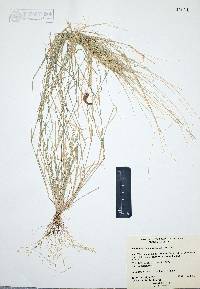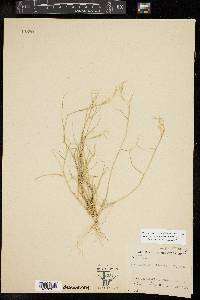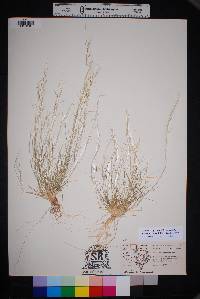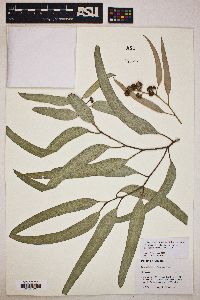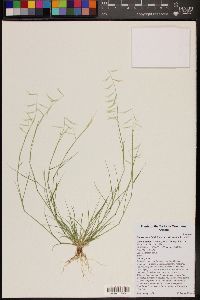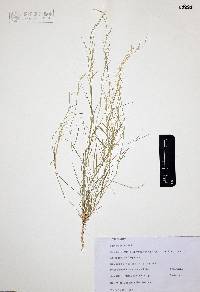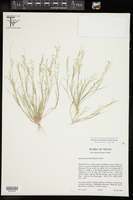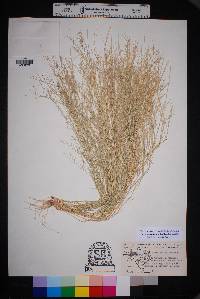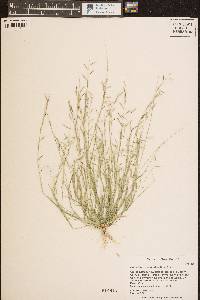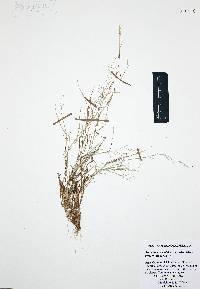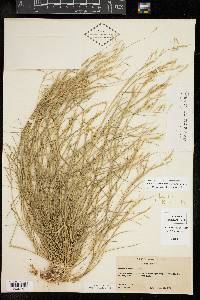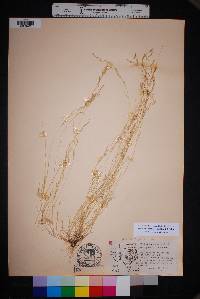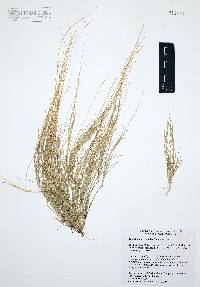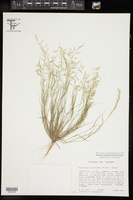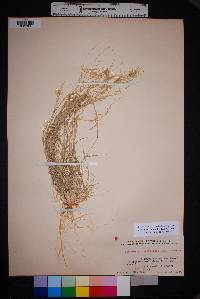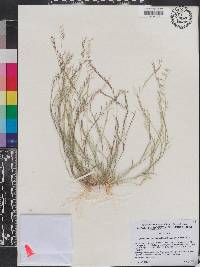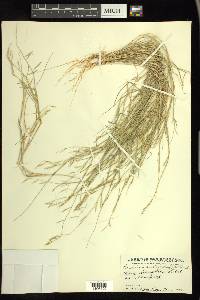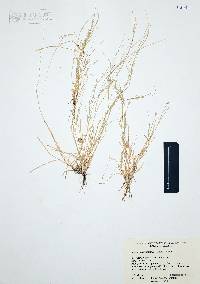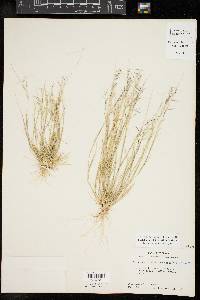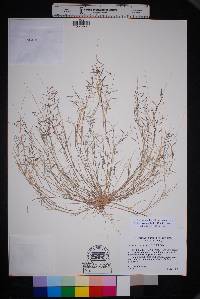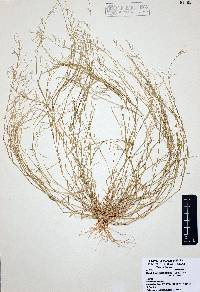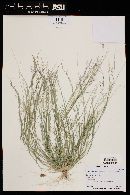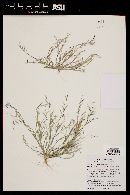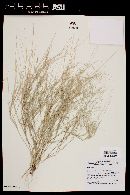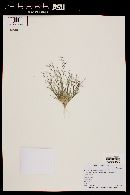Bouteloua aristidoides
|
|
|
|
Family: Poaceae
Needle Grama, more...six weeks grama, six-weeks needle grama (es: aceitilla, tochite, pasto de cabra)
[Aristida unilateralis Willd. ex Steud., moreAtheropogon aristidioides (Kunth) Roem. & Schult., Bouteloua ciliata Griseb., Dinebra aristidoides Kunth, Dinebra hirsuta J. Presl] |
Plants annual; tufted. Culms 4-60 cm, outer culms of a tuft decumbent, sometimes geniculate, branched at the lower nodes. Ligules 0.2-0.5 mm, membranous, lacerate or ciliate; blades 2-5(9) cm long, 0.7-2 mm wide, flat or folded, adaxial surfaces sometimes with papillose-based hairs, margins usually with papillose-based hairs near the ligules. Panicles 2.5-10.5 cm, with (1)4-15 branches; branches 5-45 mm, deciduous, densely pubescent (at least basally), with 2-10 spikelets per branch, axes extending 2-10 mm beyond the base of the terminal spikelets, apices entire; disarticulation at the base of the branches, the break forming a sharp tip. Spikelets appressed. Proximal spikelet on each branch with 1 floret; lower glumes 1.5-3.5 mm, glabrous, narrow to subulate; upper glumes 5.5-6.2 mm, densely pubescent, at least on the basal 1/2; lemmas 5.8-6 mm, acuminate, unawned; lowest paleas almost as long as the lemmas, bifid, glabrous; rachillas prolonged beyond the florets for about 0.5 mm. Distal spikelets with 1 bisexual and 1 rudimentary floret;glumes unequal, glabrous, minutely scabrous on the keels; narrowly acute or acuminate; lower glumes 1.5-2 mm; upper glumes 5-6 mm, glabrous or sparsely pubescent basally, often divergent; lowest lemmas 6-8 mm, veins pubescent, lateral veins excurrent as short (to 1 mm) awns, acuminate, midvein extended into a setaceous tip or a short awn; lowest paleas 5-7 mm, bifid, veins often excurrent as short awns; anthers about 2.5 mm, yellow or yellow and red; distal florets reduced to a pubescent, 3-awned, awn column, awns 2-7 mm, exserted. Caryopses 2.5-3 mm. 2n = 40. There are two varieties, both of which grow in the Flora region. Dr. David Bogler, USDA NRCS PLANTS Database Annuals, Terrestrial, not aquatic, Stems nodes swollen or brittle, Stems geniculate, decumbent, or lax, sometimes rooting at nodes, Stems caespitose, tuft ed, or clustered, Stems terete, round in cross section, or polygonal, Stems branching above base or distally at nodes, Stem internodes hollow, Stems with inflorescence less than 1 m tall, Stems, culms, or scapes exceeding basal leaves, Leaves mostly basal, below middle of stem, Leaves conspicuously 2-ranked, distichous, Leaves sheathing at base, Leaf sheath mostly open, or loose, Leaf sheath smooth, glabrous, Leaf sheath hairy at summit, throat, or collar, Leaf sheath and blade differentiated, Leaf blades linear, Leaf blades 2-10 mm wide, Leaf blades mostly flat, Leaf blade margins folded, involute, or conduplicate, Leaf blades mostly glabrous, Leaf blades more or less hairy, Leaf blades scabrous, roughened, or wrinkled, Ligule present, Ligule a fringed, ciliate, or lobed membrane, Inflorescence terminal, Inflorescence with 2 or more spikes, fascicles, glomerules, heads, or clusters per culm, Inflorescence a panicle with narrowly racemose or spicate branches, Inflorescence w ith 2-10 branches, Inflorescence branches more than 10 to numerous, Inflorescence branches 1-sided, Flowers bisexual, Spikelets sessile or subsessile, Spikelets laterally compressed, Spikelet less than 3 mm wide, Spikelets with 1 fertile floret, Spikelets solitary at rachis nodes, Spikelets all alike and fertille, Spikelets bisexual, Inflorescence branches deciduous, falling intact, Spikelets secund, in rows on one side of rachis, Rachilla or pedicel glabrous, Glumes present, empty bracts, Glumes 2 clearly present, Glumes distinctly unequal, Glumes equal to or longer than adjacent lemma, Glume equal to or longer than spikelet, Glumes 1 nerved, Lemma coriaceous, firmer or thicker in texture than the glumes, Lemma 3 nerved, Lemma glabrous, Lemma body or surface hairy, Lemma apex acute or acuminate, Lemma awnless, Lemma margins thin, lying flat, Lemma straight, Palea present, well developed, Palea membranous, hyaline, Palea shorter than lemma, Palea 2 nerved or 2 keeled, Stamen s 3, Styles 2-fid, deeply 2-branched, Stigmas 2, Fruit - caryopsis, Caryopsis ellipsoid, longitudinally grooved, hilum long-linear.
FNA 2003, Gould 1980 Common Name: needle grama Duration: Annual Nativity: Native Lifeform: Graminoid General: Annual grass; low tufted, weak stemmed, and short-lived; variable in size, fast growing with weakly developed roots. Vegetative: Blades thin, 1-2 mm broad, flat or often with few folded long stiff hairs at the base and occasionally extending up the axial surface of the blade; ligule a fringe of short hairs. Inflorescence: One-sided raceme of usually four to fifteen, occasionally twenty, short, unilateral spicate branches, these readily deciduous from the stem at a sharp-pointed callus; spicate branches 1-2 cm long, with one to four slender, appressed spikelets; rachis densely pubescent, at least near the base, flattened, extending beyond the insertion of the terminal spikelet 5-10 mm or more, conspicuously curving away from the spikelets; lowermost spikelet closely appressed to the rachis, with a single awnless floret; distal spikelets with 1 bisexual and 1 rudimentary floret; glumes unequal, glabrous, minutely scabrous on the keels; narrowly acute or acuminate; distal florets reduced to a pubescent, 3-awned column; awns 2-7 mm, exserted. Ecology: Found on dry mesas, washes, and disturbed areas below 6,000 ft (1829 m); flowers summer and fall. Notes: B. aristidoides is one of the most widespread and abundant annual grasses in the region. Look for a small delicate annual grass with few-flowered panicles superficially resembling a three-awn (Aristida). As a genus, Bouteloua is characterized by its memorable panicles, which are comprised of one to many solitary, spikelike branches. Each of these spikelike branches has 2 rows of sessile spikelets all pointing the same direction, often giving the branch a one-sided, comblike appearance. Spikelets have 1-2 or occasionally 3 florets each, but only the basal floret is bisexual; distal florets are sterile or staminate. B. aristidoides is unusual in the genus in that it has so few flowers on each spikelike branch that without magnification, each branch appears to be a single spikelet. The 3-awned structures that give the species its name emerge from the rudimentary upper florets of the spikelets. Two varieties are known in the region: var. aristidoides and var. arizonica. They are distinguished by the former having branches with only 2-5 spikelets per branch, with the axis extending 6-10 mm beyond the terminal spikelet; the latter has branches with 6-10 spikelets and the axis only extends 2-5 mm beyond the terminal spikelet. Ethnobotany: Unknown, check other species in genus for many uses. Etymology: Bouteloua named for brothers Claudio (1774-1842) and Esteban (1776-1813) Boutelou Agraz, Spanish botanists and horticulturalists; aristidoides means like Aristida, with the three-awned lemma. Synonyms: None Editor: SBuckley 2010; AHazelton 2015 |
|
|
|

